BY ALLAN ASHEMAN
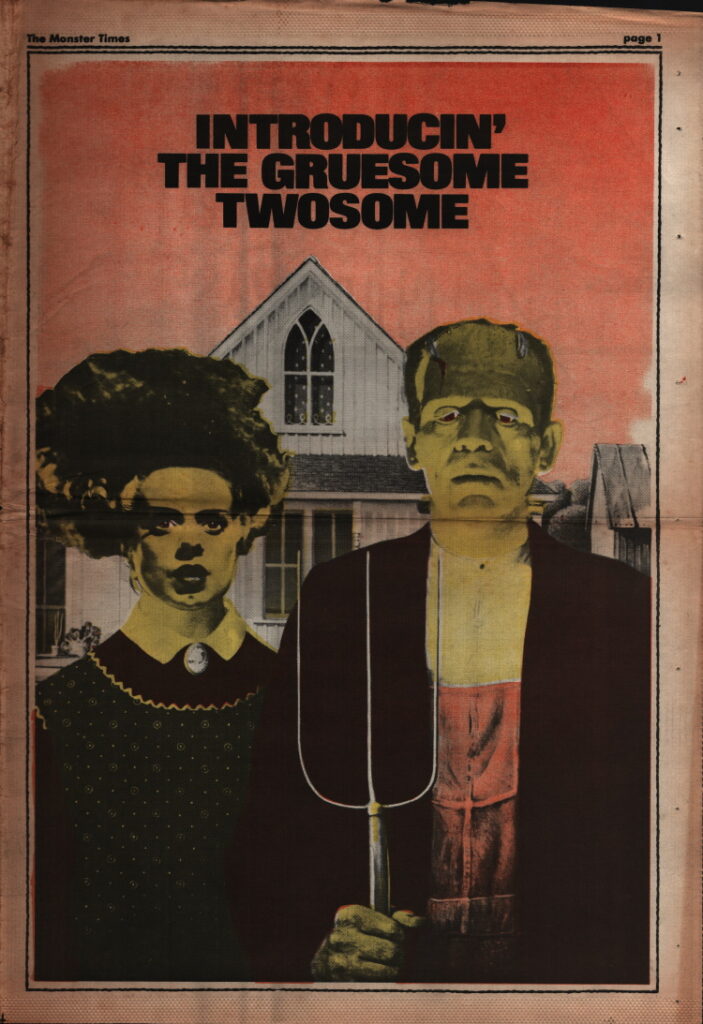
INTRODUCIN’ THE GRUESOME TWOSOME
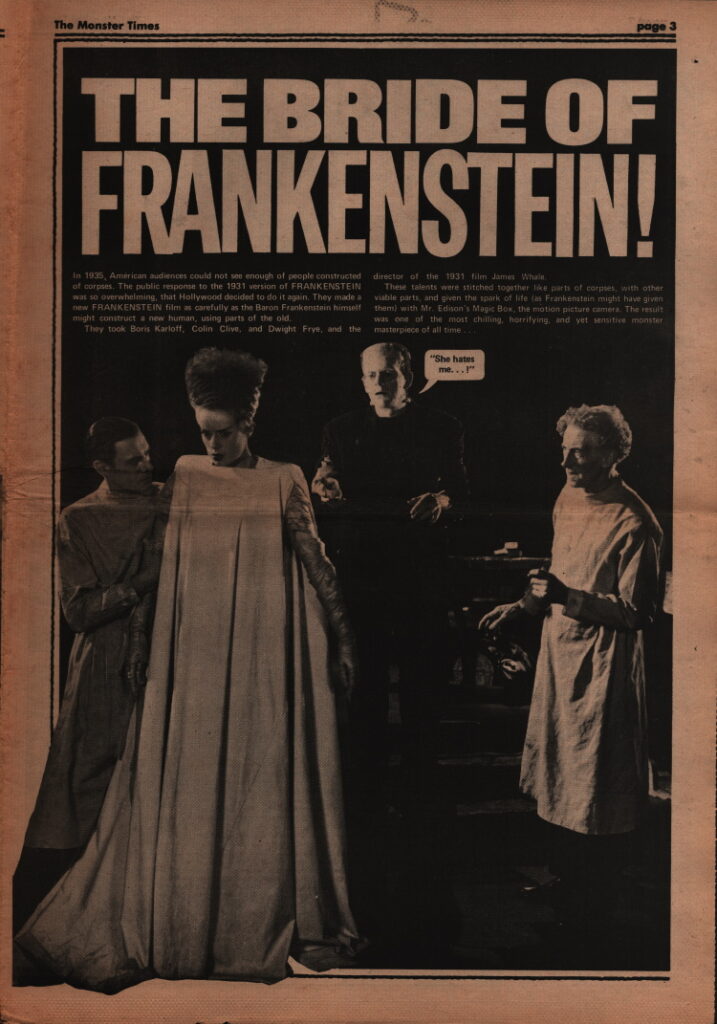
THE BRIDE OF FRANKENSTEIN!
In 1935, American audiences could not see enough of people constructed of corpses. The public response to the 1931 version of FRANKENSTEIN was so overwhelming, that Hollywood decided to do it again. They made a new FRANKENSTEIN film as carefully as the Baron Frankenstein himself might construct a new human, using parts of the old.
They took Boris Karloff, Colin Clive, and Dwight Frye, and the director of the 1931 film James Whale,
These talents were stitched together like parts of corpses, with other viable parts, and given the spark of life (as Frankenstein might have given them) with Mr. Edison’s Magic Box, the motion picture camera, The result was one of the most chilling, horrifying, and yet sensitive monster masterpiece of all time…
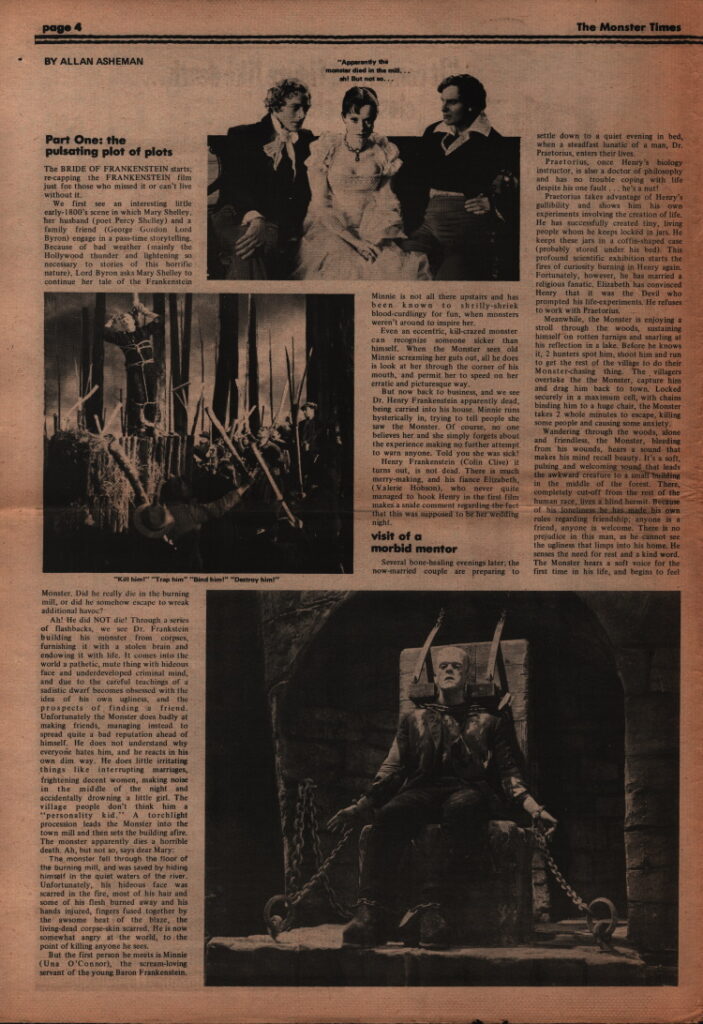
Part One: the pulsating plot of plots
The BRIDE OF FRANKENSTEIN starts; re-capping the FRANKENSTEIN film just for those who missed it or can’t live without it.
We first see an interesting little early-1800’s scene in which Mary Shelley, her husband (poet Percy Shelley) and a family friend (George Gordon Lord Byron) engage in a pass-time storytelling. Because of bad weather (mainly the Hollywood thunder and lightening so necessary to stories of this horrific nature), Lord Byron asks Mary Shelley to continue her tale of the Frankenstein Monster. Did he really die in the burning mill, or did he somehow escape to wreak additional havoc?
Ah! He did NOT die! Through a series of flashbacks, we see Dr. Frankstein building his monster from corpses, furnishing it with a stolen brain and endowing it with life. It comes into the world a pathetic, mute thing with hideous face and underdeveloped criminal mind, and due to the careful teachings of a sadistic dwarf becomes obsessed with the idea of his own ugliness, and the prospects of finding a friend. Unfortunately the Monster does badly at making friends, managing instead to spread quite a bad reputation ahead of himself. He does not understand why everyone hates him, and he reacts in his own dim way. He does little irritating things like interrupting marriages, frightening decent women, making noise in the middle of the night and accidentally drowning a little girl. The village people don’t think him a “personality kid.” A torchlight procession leads the Monster into the town mill and then sets the building afire. The monster apparently dies a horrible death. Ah, but not so, says dear Mary:
The monster fell through the floor of the burning mill, and was saved by hiding himself in the quiet waters of the river. Unfortunately, his hideous face was scarred in the fire, most of his hair and some of his flesh burned away and his hands injured, fingers fused together by the awsome heat of the blaze, the living-dead corpse-skin scarred. He is now somewhat angry at the world, to the point of killing anyone he sees.
But the first person he meets is Minnie (Una O’Connor), the scream-loving servant of the young Baron Frankenstein.
Minnie is not all there upstairs and has been known to shrilly-shriek blood-curdlingy for fun, when monsters weren’t around to inspire her.
Even an eccentric, kill-crazed monster can recognize someone sicker than himself. When the Monster sees old Minnie screaming her guts out, all he does is look at her through the corner of his mouth, and permit her to speed on her erratic and picturesque way.
But now back to business, and we see Dr. Henry Frankenstein apparently dead, being carried into his house. Minnie runs hysterically in, trying to tell people she saw the Monster. Of course, no one believes her and she simply forgets about the experience making no further attempt to warn anyone. Told you she was sick!
Henry Frankenstein (Colin Clive) it! turns out, is not dead. There is much merry-making, and his fiance Elizabeth, (Valerie Hobson), who never quite managed to hook Henry in the first film makes a snide comment regarding the fact that this was supposed to be her wedding night.
visit of a morbid mentor
Several bone-healing evenings later; the now-married couple are preparing to settle down to a quiet evening in bed, when a steadfast lunatic of a man, Dr. Praetorius, enters their lives.
Praetorius, once Henry’s biology instructor, is also a doctor of philosophy and has no trouble coping with life despite his one fault … he’s a nut!
Praetorius takes advantage of Henry’s gullibility and shows him his own experiments involving the creation of life. He has successfully created tiny, living people whom he keeps locked in jars. He keeps these jars in a coffin-shaped case (probably stored under his bed). This profound scientific exhibition starts the fires of curiosity burning in Henry again. Fortunately, however, he has married a religious fanatic. Elizabeth has convinced Henry that it was the Devil who prompted his life-experiments. He refuses to work with Praetorius.
Meanwhile, the Monster is enjoying a stroll through the woods, sustaining himself on rotten turnips and snarling at his reflection in a lake. Before he knows it, 2 hunters spot him, shoot him and run to get the rest of the village to do their Monster-chasing thing. The villagers overtake the the Monster, capture him and drag him back to town. Locked securely in a maximum cell, with chains binding him to a huge chair, the Monster takes 2 whole minutes to escape, killing some people and causing some anxiety.
Wandering through the woods, alone and friendless, the Monster, bleeding from his wounds, hears a sound that makes his mind recall beauty. It’s a soft, pulsing and welcoming sound that leads the awkward creature to a small building in the middle of the forest. There, completely cut-off from the rest of the human race, lives a blind hermit. Because of his loneliness he has made his own rules regarding friendship; anyone is a friend, anyone is welcome. There is no prejudice in this man, as he cannot see the ugliness that limps into his home. He senses the need for rest and a kind word. The Monster hears a soft voice for the first time in his life, and begins to feel compassion for the blind man. He eats food offered to him by the blind Hermit and exhibits the most necessary of all human reactions: trust. He cries as the Hermit thanks God for sending him a friend from out of the darkness. The Hermit plays a great but sad violin. The Monster learns to cry a lot.
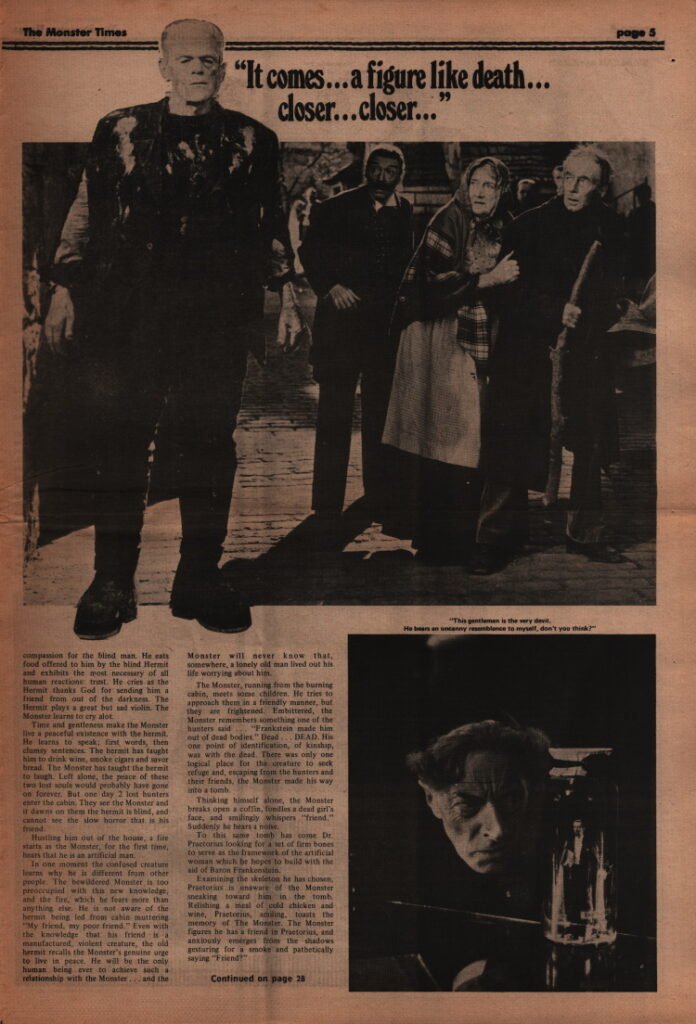
Time and gentleness make the Monster live a peaceful existence with the hermit. He learns to speak; first words, then clumsy sentences. The hermit has taught him to drink wine, smoke cigars and savor bread. The Monster has taught the hermit! to laugh. Left alone, the peace of these two lost souls would probably have gone on forever. But one day 2 lost hunters enter the cabin. They see the Monster and it dawns on them the hermit is blind, and cannot see the slow horror that is his friend.
Hustling him out of the house, a fire starts as the Monster, for the first time, hears that he is an artificial man.
In one moment the confused creature learns why he is different from other people. The bewildered Monster is too preoccupied with this new knowledge, and the fire, which he fears more than anything else. He is not aware of the hermit being led from cabin muttering “My friend, my poor friend.” Even with the knowledge that his friend is a manufactured, violent creature, the old hermit recalls the Monster’s genuine urge to live in peace. He will be the only human being ever to achieve such a relationship with the Monster … and the Monster will never know that, somewhere, a lonely old man lived out his life worrying about him.
The Monster, running from the burning cabin, meets some children. He tries to approach them in a friendly manner, but they are frightened. Embittered, the Monster remembers something one of the hunters said … “Frankstein made him out of dead bodies.” Dead … DEAD. His one point of identification, of kinship, was with the dead. There was only one logical place for the creature to seek refuge and, escaping from the hunters and their friends, the Monster made his way into a tomb.
Thinking himself alone, the Monster breaks open a coffin, fondles a dead girl’s face, and smilingly whispers “friend.” Suddenly he hears a noise.
To this same tomb has come Dr. Praetorius looking for a set of firm bones to serve as the framework of the artificial woman which he hopes to build with the aid of Baron Frankenstein
Examining the skeleton he has chosen. Praetorius is unaware of the Monster sneaking toward him in the tomb. Relishing a meal of cold chicken and wine, Praetorius, smiling, toasts the memory of The Monster. The Monster figures he has a friend in Praetorius, and anxiously emerges from the shadows gesturing for a smoke and pathetically saying “Friend?”
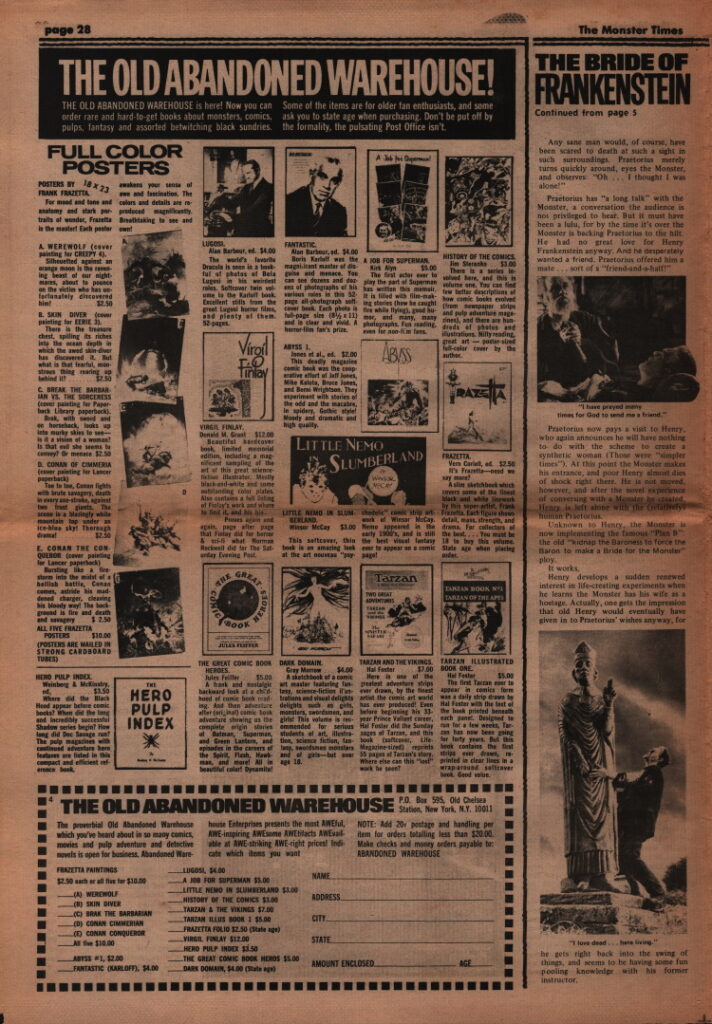
THE BRIDE OF FRANKENSTEIN
Any sane man would, of course, have been scared to death at such a sight in such surroundings. Praetorius merely turns quickly around, eyes the Monster, and observes: “Oh… I thought I was alone!”
Praetorius has “a long talk” with the Monster, a conversation the audience is nou privileged to hear. But it must have been a lulu, for by the time it’s over the Monster is backing Praetorius to the hilt. “He had no great love for Henry Frankenstein anyway. And he desperately! wanted a friend. Praetorius offered him a mate… sort of a “friend-and-a-half!”
Praetorius now pays a visit to Henry, who again announces he will have nothing to do with the scheme to create a synthetic woman (Those were “simpler times”). At this point the Monster makes his entrance, and poor Henry almost dies of shock right there. He is not moved, however, and after the novel experience of conversing with a Monster he created, Henry is left alone with the (relatively) human Praetorius.
Unknown to Henry, the Monster is now implementing the famous “Plan B”: the old “kidnap the Baroness to force the Baron to make a Bride for the Monster” ploy.
It works.
Henry develops a sudden renewed interest in life-creating experiments when he learns the Monster has his wife as a hostage. Actually, one gets the impression that old Henry would eventually have given in to Praetorius’ wishes anyway, for he gets right back into the swing of things, and seems to be having some fun pooling knowledge with his former instructor.
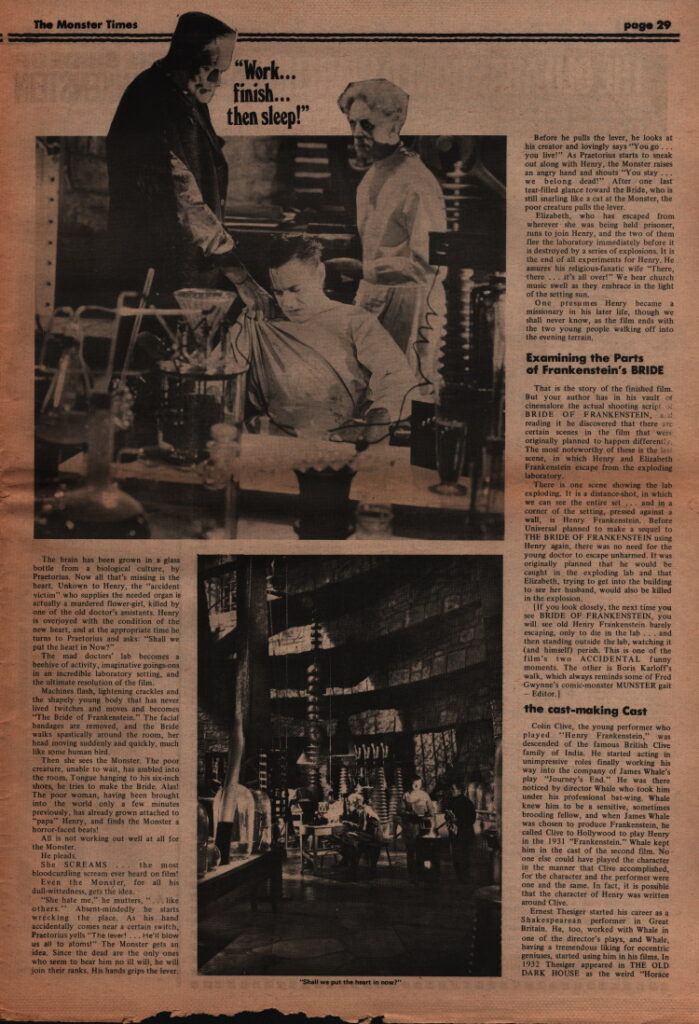
The brain has been grown in a glass bottle from a biological culture, by Praetorius. Now all that’s missing is the heart. Unkown to Henry, the “accident victim” who supplies the needed organ is actually a murdered flower-girl, killed by one of the old doctor’s assistants. Henry is overjoyed with the condition of the new heart, and at the appropriate time he turns to Praetorius and asks: “Shall we put the heart in Now?”
The mad doctors lab becomes a beehive of activity, imaginative goings-ons in an incredible laboratory setting, and the ultimate resolution of the film.
Machines flash, lightening crackles and the shapely young body that has never lived twitches and moves and becomes “The Bride of Frankenstein.” The facial bandages are removed, and the Bride walks spastically around the room, her head moving suddenly and quickly, much! like some human bird.
Then she sees the Monster. The poor creature, unable to wait, has ambled into the room. Tongue hanging to his six-inch shoes, he tries to make the Bride. Alas! The poor woman, having been brought into the world only a few minutes previously, has already grown attached to “papa” Henry, and finds the Monster a horror-faced beats!
All is not working out well at all for the Monster.
He pleads.
She SCREAMS … the most bloodcurdling scream ever heard on film!
Even the Monster, for all his dull-wittedness, gets the idea.
“She hate me,” he mutters,”… like others.” Absent-mindedly he starts wrecking the place. As his hand accidentally comes near a certain switch, Praetorius yells “The lever! … He’ll blow! us all to atoms!” The Monster gets an idea. Since the dead are the only ones who seem to bear him no ill will, he will join their ranks. His hands grips the lever.
Before he pulls the lever, he looks at his creator and lovingly says “You go… you live!” As Praetorius starts to sneak! out along with Henry, the Monster raises an angry hand and shouts “You stay .. we belong dead!” After one last tear-filled glance toward the Bride, who is still snarling like a cat at the Monster, the poor creature pulls the lever.
Elizabeth, who has escaped from wherever she was being held prisoner, runs to join Henry, and the two of them flee the laboratory immediately before it is destroyed by a series of explosions. It is the end of all experiments for Henry. He assures his religious-fanatic wife “There, there … it’s all over!” We hear church music swell as they embrace in the light of the setting sun.
One presumes Henry became a missionary in his later life, though we shall never know, as the film ends with the two young people walking off into the evening terrain.
Examining the Parts of Frankenstein’s BRIDE
That is the story of the finished film. But your author has in his vault of cinemalore the actual shooting script of BRIDE OF FRANKENSTEIN, and reading it he discovered that there are certain scenes in the film that were originally planned to happen differently. The most noteworthy of these is the last scene, in which Henry and Elizabeth Frankenstein escape from the exploding laboratory.
There is one scene showing the lab exploding. It is a distance-shot, in which we can see the entire set … and in a corner of the setting, pressed against a wall, is Henry Frankenstein. Before Universal planned to make a sequel to THE BRIDE OF FRANKENSTEIN using Henry again, there was no need for the young doctor to escape unharmed. It was originally planned that he would be caught in the exploding lab and that Elizabeth, trying to get into the building to see her husband, would also be killed in the explosion.
[If you look closely, the next time you see BRIDE OF FRANKENSTEIN, you will see old Henry Frankenstein barely escaping, only to die in the lab … and then standing outside the lab, watching it (and himself) perish. This is one of the film’s two ACCIDENTAL funny moments. The other is Boris Karloff’s walk, which always reminds some of Fred Gwynne’s comic-monster MUNSTER gait – Editor.]
the cast-making Cast
Colin Clive, the young performer who played “Henry Frankenstein,” was descended of the famous British Clive family of India. He started acting in unimpressive roles finally working his way into the company of James Whale’s play “Journey’s End.” He was there noticed by director Whale who took him under his professional bat-wing. Whale knew him to be a sensitive, sometimes brooding fellow, and when James Whale was chosen to produce Frankenstein, he called Clive to Hollywood to play Henry in the 1931 “Frankenstein,” Whale kept him in the cast of the second film. No one else could have played the character in the manner that Clive accomplished, for the character and the performer were one and the same. In fact, it is possible that the character of Henry was written around Clive.
Ernest Thesiger started his career as a Shakespearean performer in Great Britain. He, too, worked with Whale in one of the director’s plays, and Whale, having a tremendous liking for eccentric geniuses, started using him in his films. In 1932 Thesiger appeared in THE OLD DARK HOUSE as the weird “Horace Femme.” Like “Dr. Praetorius” Femme also liked gin.
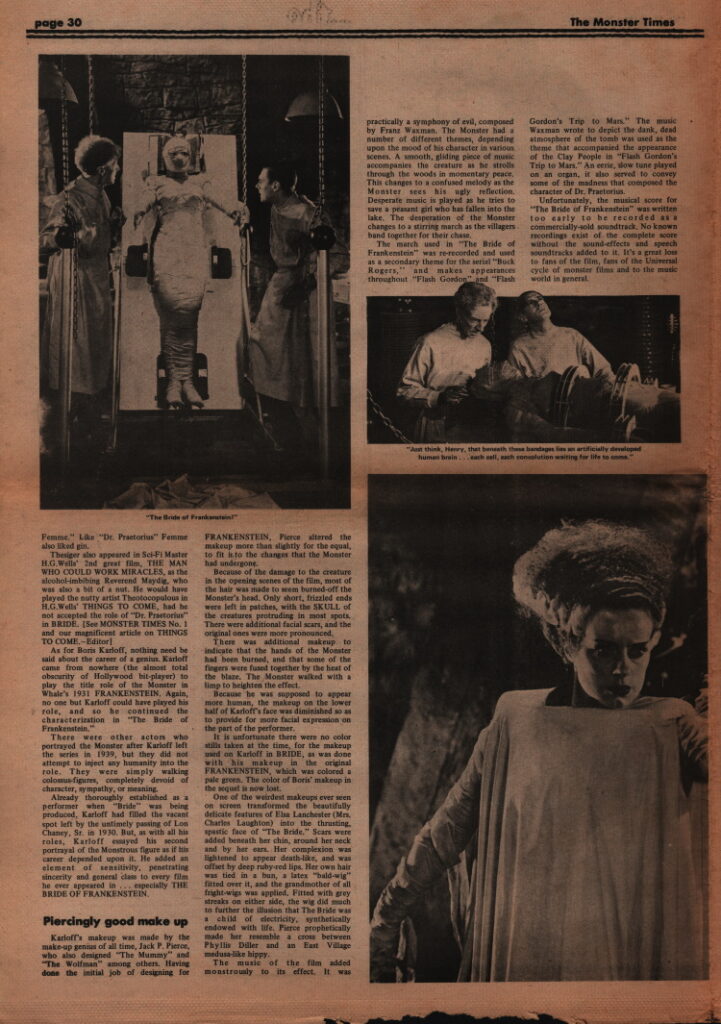
Thesiger also appeared in Sci-Fi Master H.G.Wells’ 2nd great film, THE MAN WHO COULD WORK MIRACLES, as the alcohol-imbibing Reverend Maydig, who was also a bit of a nut. He would have played the nutty artist Theotocopulous in H.G.Wells’ THINGS TO COME, had he not accepted the role of “Dr. Praetorius” in BRIDE. (See MONSTER TIMES No. 1 and our magnificent article on THINGS TO COME.-Editor]
As for Boris Karloff, nothing need be said about the career of a genius. Karloff came from nowhere (the almost total obscurity of Hollywood bit-player) to play the title role of the Monster in Whale’s 1931 FRANKENSTEIN. Again, no one but Karloff could have played his role, and so he continued the characterization in “The Bride of Frankenstein.”
There were other actors who portrayed the Monster after Karloff left the series in 1939, but they did not attempt to inject any humanity into the role. They were simply walking colossus-figures, completely devoid of character, sympathy, or meaning.
Already thoroughly established as a performer when “Bride” was being produced, Karloff had filled the vacant spot left by the untimely passing of Lon Chaney, Sr. in 1930. But, as with all his roles, Karloff essayed his second portrayal of the Monstrous figure as if his career depended upon it. He added an element of sensitivity, penetrating sincerity and general class to every film he ever appeared in … especially THE BRIDE OF FRANKENSTEIN.
Piercingly good make up
Karloff’s makeup was made by the make-up genius of all time, Jack P. Pierce, who also designed “The Mummy” and “The Wolfman” among others. Having done the initial job of designing for FRANKENSTEIN, Pierce altered the makeup more than slightly for the equal, to fit into the changes that the Monster had undergone.
Because of the damage to the creature in the opening scenes of the film, most of the hair was made to seem burned-off the Monster’s head. Only short, frizzled ends were left in patches, with the SKULL of the creatures protruding in most spots. There were additional facial scars, and the original ones were more pronounced.
There was additional makeup to indicate that the hands of the Monster had been burned, and that some of the fingers were fused together by the heat of the blaze. The Monster walked with a limp to heighten the effect.
Because he was supposed to appear more human, the makeup on the lower half of Karloff’s face was diminished so as to provide for more facial expression on the part of the performer.
It is unfortunate there were no color stills taken at the time, for the makeup used on Karloff in BRIDE, as was done with his makeup in the original FRANKENSTEIN, which was colored a pale green. The color of Boris’ makeup in the sequel is now lost.
One of the weirdest makeups ever seen on screen transformed the beautifully delicate features of Elsa Lanchester (Mrs. Charles Laughton) into the thrusting, spastic face of “The Bride.” Scars were added beneath her chin, around her neck and by her ears. Her complexion was lightened to appear death-like, and was offset by deep ruby-red lips. Her own hair was tied in a bun, a latex “bald-wig” fitted over it, and the grandmother of all fright-wigs was applied. Fitted with grey streaks on either side, the wig did much to further the illusion that The Bride was a child of electricity, synthetically endowed with life. Pierce prophetically made her resemble a cross between Phyllis Diller and an East Village medusa-like hippy.
The music of the film added monstrously to its effect. It was practically a symphony of evil, composed by Franz Waxman. The Monster had a number of different themes, depending upon the mood of his character in various scenes. A smooth, gliding piece of music accompanies the creature as he strolls through the woods in momentary peace. This changes to a confused melody as the Monster sees his ugly reflection. Desperate music is played as he tries to save a peasant girl who has fallen into the lake. The desperation of the Monster changes to a stirring march as the villagers band together for their chase.
The march used in “The Bride of Frankenstein” was re-recorded and used as a secondary theme for the serial “Buck! Rogers,” and makes appearances throughout “Flash Gordon” and “Flash
Gordon’s Trip to Mars.” The music Waxman wrote to depict the dank, dead atmosphere of the tomb was used as the theme that accompanied the appearance of the Clay People in “Flash Gordon’s Trip to Mars.” An eerie, slow tune played on an organ, it also served to convey some of the madness that composed the character of Dr. Praetorius.
Unfortunately, the musical score for “The Bride of Frankenstein” was written too early to be recorded as a commercially-sold soundtrack. No known recordings exist of the complete score without the sound effects and speech soundtracks added to it. It’s a great loss to fans of the film, fans of the Universal cycle of monster films and to the music world in general.
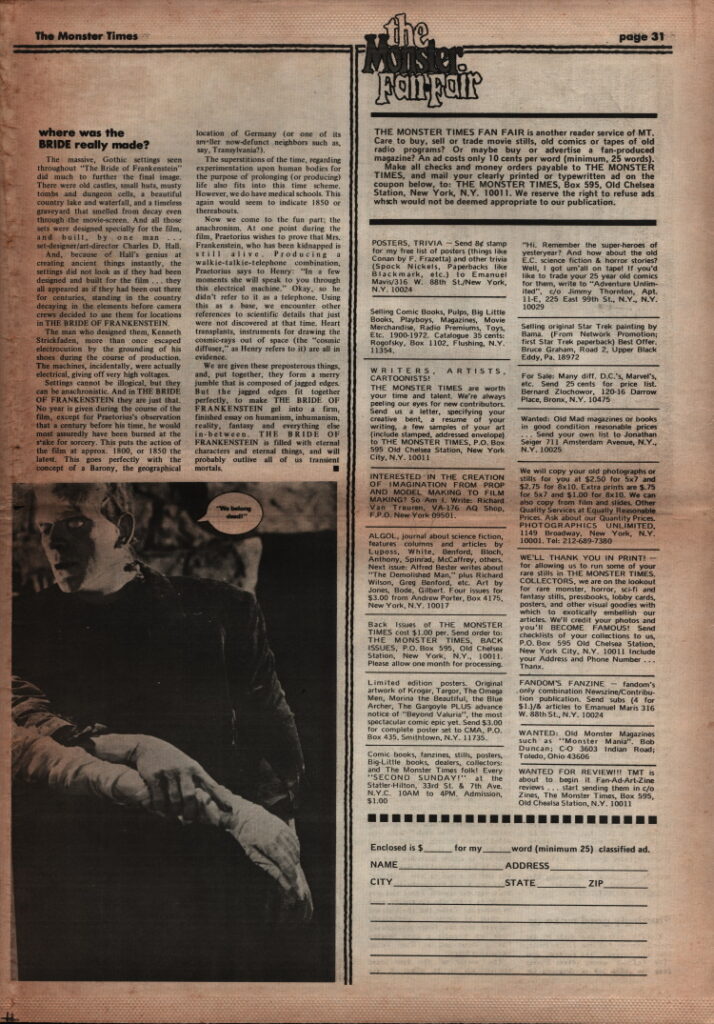
where was the BRIDE really made?
The massive, Gothic settings seen throughout “The Bride of Frankenstein” did much to further the final image. There were old castles, small huts, musty tombs and dungeon cells, a beautiful country lake and waterfall, and a timeless graveyard that smelled from decay even through the movie screen. And all those sets were designed specially for the film, and built by one-man set designer/art director Charles D. Hall.
And, because of Hall’s genius at creating ancient things instantly, the settings did not look as if they had been designed and built for the film … they all appeared as if they had been out there for centuries, standing in the country decaying in the elements before camera crews decided to use them for locations! in THE BRIDE OF FRANKENSTEIN.
The man who designed them, Kenneth Strickfaden, more than once escaped electrocution by the grounding of his shoes during the course of production. The machines, incidentally, were actually electrical, giving off very high voltages.
Settings cannot be illogical, but they can be anachronistic. And in THE BRIDE OF FRANKENSTEIN they are just that. No year is given during the course of the film, except for Praetorius’s observation that a century before his time, he would most assuredly have been burned at the stake for sorcery. This puts the action of the film at approx. 1800, or 1850 the latest. This goes perfectly with the concept of a Barony, the geographical location of Germany (or one of its smaller now-defunct neighbors such as, say, Transylvania?).
The superstitions of the time, regarding experimentation upon human bodies for the purpose of prolonging (or producing) life also fits into this time scheme. However, we do have medical schools. This again would seem to indicate 1850 or thereabouts.
Now we come to the fun part; the anachronism. At one point during the film, Praetorius wishes to prove that Mrs. Frankenstein, who has been kidnapped is still alive. Producing a walkie-talkie-telephone combination, Praetorius says to Henry: “In a few moments she will speak to you through this electrical machine.” Okay, so he didn’t refer to it as a telephone. Using! this as a base, we encounter other references to scientific details that just were not discovered at that time. Heart transplants, instruments for drawing the cosmic rays out of space (the “cosmic diffuser,” as Henry refers to it) are all in evidence.
We are given these preposterous things, and, put together, they form a merry jumble that is composed of jagged edges. But the jagged edges fit together perfectly, to make. THE BRIDE OF FRANKENSTEIN gel into a firm, finished essay on humanism, inhumanism, reality, fantasy and everything else in-between. THE BRIDE OF! FRANKENSTEIN is filled with eternal characters and eternal things, and will probably outlive all of us transient! mortals.
